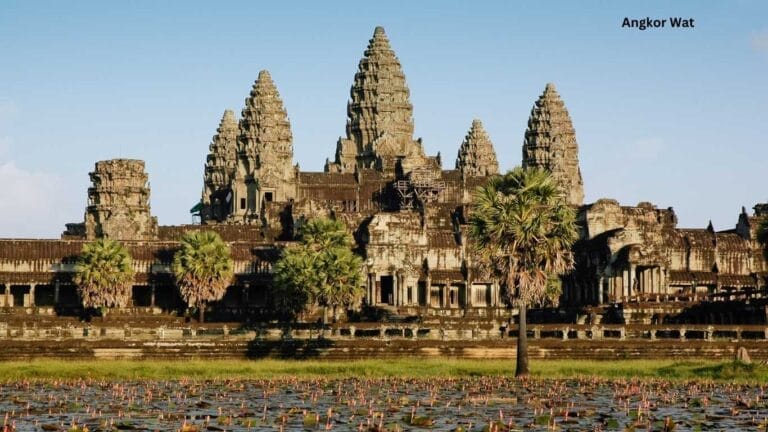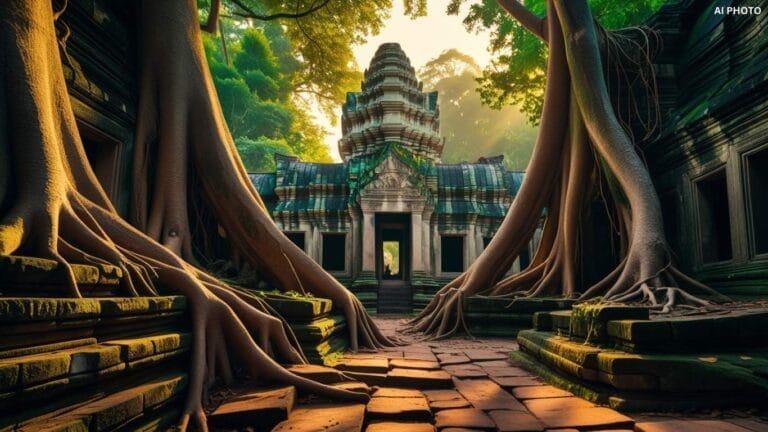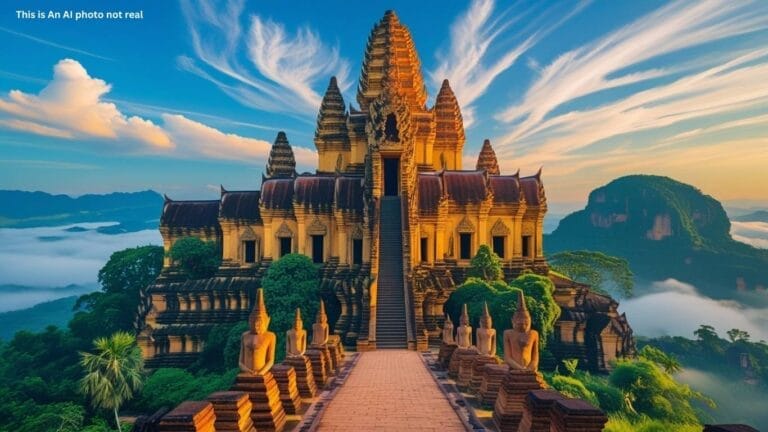Cambodia, a land steeped in history and spirituality, offers travelers an enchanting glimpse into a world where ancient temples stand as guardians of time. These breathtaking monuments not only reveal the architectural brilliance of a bygone era but also tell stories of profound spiritual devotion. Reflecting on my visit to this captivating land, I can confidently say that exploring Cambodia’s mystical temples is like stepping into the pages of history.
1. Angkor Wat: The Crown Jewel of Cambodia

Angkor Wat, often called the crown jewel of Cambodia, is a breathtaking symbol of the country’s history and culture. Located in the heart of Siem Reap’s lush landscapes, this vast temple complex is the largest religious monument in the world. Built in the 12th century by the Khmer Empire, it was originally dedicated to the Hindu god Vishnu and later became a Buddhist sanctuary. Its design is a stunning mix of spiritual symbolism and architectural mastery, with its towering spires, intricate carvings, and vast galleries telling stories of gods, kings, and epic battles.
One of the most magical moments at Angkor Wat is watching the sunrise. As the first rays of light touch the temple, its silhouette reflects beautifully in the surrounding moat, creating a scene that feels almost like a dream. Walking through its corridors, you can feel the weight of history in every stone, as if the walls themselves are whispering tales of the past.
Angkor Wat is more than just a monument; it is a connection to Cambodia’s soul. It invites travelers to experience its timeless beauty, rich heritage, and the profound sense of peace that fills its sacred grounds. Whether you are exploring its ancient carvings or simply soaking in the serene atmosphere, Angkor Wat is a place that will stay with you long after your visit.
Architectural Splendor: 🏛️
I was left speechless by the intricate bas-reliefs, the soaring towers, and the vast moat that surround Angkor Wat. The central tower, symbolizing Mount Meru—the center of the universe in Hindu cosmology—commands attention and reverence. Walking along the outer gallery walls, I marveled at carvings that brought epic tales from the Mahabharata and Ramayana to life.Best Time to Visit: 🌅
Sunrise at Angkor Wat is an experience I’ll never forget. Watching the first light of day illuminate the temple’s silhouette was pure magic. If you prefer quieter moments, late afternoons provide a golden glow that enhances the temple’s majesty.Cultural Significance: 🇰🇭
Seeing Angkor Wat on Cambodia’s flag and currency after visiting it in person gave me a deeper appreciation for its role in the nation’s identity. This temple is more than an architectural marvel—it’s a symbol of Cambodia’s enduring spirit.
2. Ta Prohm: The Temple Embraced by Nature

Ta Prohm, famously known as the “Temple Embraced by Nature,” is one of Cambodia’s most enchanting and mysterious landmarks. Nestled within the Angkor Archaeological Park near Siem Reap, this ancient temple offers a unique glimpse into the harmonious yet powerful relationship between man-made structures and the natural world. Built in the late 12th and early 13th centuries by King Jayavarman VII as a Buddhist monastery and university, Ta Prohm stands out for its evocative beauty.
Unlike other restored temples, Ta Prohm has been left largely untouched, allowing nature to weave itself into the temple’s very fabric. Giant silk-cotton and strangler fig trees rise dramatically from the ruins, their roots snaking through stone walls and carvings, as if reclaiming the site for the earth. The interplay of light and shadow among the moss-covered stones and the towering trees creates an atmosphere that feels both timeless and otherworldly.
Visitors to Ta Prohm often describe it as stepping into a scene from a lost world, with its labyrinth of crumbling corridors, weathered sculptures, and ancient courtyards. The temple’s iconic image, immortalized in films like Lara Croft: Tomb Raider, has captured the imagination of travelers worldwide. Yet, despite its fame, Ta Prohm retains an air of solitude and mystique, making it a favorite for those seeking a quieter, more reflective experience.
Exploring Ta Prohm is like traveling back in time. Each turn reveals a new story etched into its stones, and every corner offers a breathtaking view of nature’s resilience and beauty. Whether it’s the intricate carvings peeking out from beneath a canopy of green or the sheer scale of the trees entwined with the ruins, Ta Prohm leaves visitors in awe. It’s a place where history and nature blend seamlessly, reminding us of the enduring power of both.
Why It’s Special: 🌳
Walking through Ta Prohm felt like stepping into a dream. Giant silk-cotton and fig trees have woven themselves into the temple’s structure, creating an otherworldly atmosphere. The interplay of roots and crumbling walls was both haunting and beautiful.Tips for Visitors: 🕊️
Visiting early in the morning allowed me to enjoy the serene environment without the crowds. The tranquility of the site, accompanied by the sounds of chirping birds and rustling leaves, was unforgettable.Historical Insights: 📜
Originally known as Rajavihara, Ta Prohm was once a thriving spiritual and academic hub. Imagining the lives of the monks and scholars who once walked these paths added depth to my visit.
3. Bayon Temple: Faces of Serenity

Bayon Temple, often referred to as the “Faces of Serenity,” is one of the most iconic and captivating temples within Cambodia’s Angkor complex. Located at the heart of Angkor Thom, the last capital of the Khmer Empire, Bayon is renowned for its majestic towers adorned with enigmatic smiling faces. Built in the late 12th century by King Jayavarman VII, the temple is a stunning example of the fusion of spiritual devotion and architectural artistry.
The temple’s most striking feature is its 54 towers, each bearing four massive faces that gaze serenely in all directions. These faces, believed to represent either the bodhisattva Avalokiteshvara or the king himself, embody a sense of calm and spiritual transcendence. As you wander through the temple’s intricate corridors and climb its steep stairways, you are surrounded by an aura of peace and mystery, heightened by the play of light and shadow on the stone surfaces.
In addition to its famous faces, Bayon Temple is adorned with intricate bas-reliefs that depict scenes of everyday Khmer life, epic battles, and religious rituals. These carvings provide a vivid window into the history and culture of the Khmer Empire, offering visitors a chance to connect with the past through the stories etched into the temple’s walls.
The atmosphere at Bayon Temple is particularly magical during sunrise or sunset, when the soft light illuminates the stone faces, enhancing their serene expressions. The temple’s unique design, blending Buddhist and Hindu elements, reflects the complex religious and cultural dynamics of the time.
Visiting Bayon Temple is a journey into the heart of Cambodia’s spiritual and historical heritage. Its timeless beauty, combined with the profound sense of tranquility exuded by its smiling faces, makes it an unforgettable destination for travelers seeking inspiration and connection with the past. Whether you’re exploring its carvings or simply standing in awe of its grandeur, Bayon Temple leaves a lasting impression of serenity and wonder.
Symbolism: 😊
The serene expressions on the faces, possibly representing the king or Avalokiteshvara, the Bodhisattva of compassion, seemed to radiate peace. Standing among them, I felt a profound sense of calm and wonder.Highlight: 🎭
The bas-reliefs were another highlight, depicting vivid scenes of daily life in the Khmer empire. From bustling markets to naval battles, these carvings painted a picture of a vibrant civilization.Visitor Experience: 🔍
Exploring the labyrinthine corridors and hidden chambers was like being on an archaeological treasure hunt. Each turn revealed new perspectives of the iconic faces, making every moment memorable.
4. Banteay Srei: The Jewel of Khmer Art

Banteay Srei, often called the “Jewel of Khmer Art,” is a masterpiece of intricate design and exquisite craftsmanship. Located about 25 kilometers northeast of the main Angkor complex, this small but breathtaking temple stands out for its stunning pink sandstone construction and highly detailed carvings that have earned it worldwide admiration. Built in the 10th century and dedicated to the Hindu god Shiva, Banteay Srei showcases the artistic brilliance of the Khmer civilization.
What makes Banteay Srei unique is the exceptional quality of its carvings. Every inch of the temple is adorned with intricate patterns, floral motifs, and scenes from Hindu mythology, including tales from the Ramayana and Mahabharata. Despite its smaller scale compared to other Angkorian temples, the fine detailing of Banteay Srei’s architecture exudes a sense of grandeur and sophistication that captivates visitors. The warm hues of the pink sandstone, coupled with the temple’s delicate artistry, give it an almost jewel-like appearance, especially under the soft light of morning or late afternoon.
The temple’s layout, centered around three sanctuaries, is a testament to the Khmer’s mastery of proportion and harmony. Its compact size makes it feel intimate and inviting, allowing visitors to closely observe the remarkable artistry up close. The carvings, some of which are in astonishingly pristine condition, feature mythical creatures, celestial dancers, and elaborate scenes that narrate ancient stories with stunning clarity.
Banteay Srei’s relatively remote location adds to its charm, offering a more serene and contemplative experience compared to the busier sites within Angkor. The surrounding countryside, with its rice paddies and small villages, further enhances the sense of stepping back in time. Visiting Banteay Srei is not just about admiring its beauty; it is also an opportunity to connect with the deep cultural and spiritual roots of Cambodia.
For travelers seeking to explore the artistic pinnacle of the Khmer Empire, Banteay Srei is an unmissable destination. Its unparalleled carvings, intimate scale, and tranquil setting make it a true gem among the treasures of Angkor, leaving a lasting impression of wonder and admiration.
What Makes It Unique: 💎
The carvings at Banteay Srei were unlike anything I’d seen before. Scenes from Hindu mythology were rendered with such precision that it felt like stepping into a divine narrative.Travel Tip: 🚗
A day trip to Banteay Srei also gave me a chance to explore the Cambodian countryside. The Landmine Museum nearby was a poignant reminder of the country’s resilience in the face of adversity.Best Time to Visit: 📸
Early morning visits are ideal, as the pink sandstone takes on a warm glow that’s perfect for photography.
5. Preah Vihear: A Temple Above the Clouds

Preah Vihear, known as the “Temple Above the Clouds,” is a majestic and remote sanctuary perched high atop the Dângrêk Mountains along the Cambodia-Thailand border. This UNESCO World Heritage Site offers not only breathtaking architectural splendor but also awe-inspiring views of the surrounding landscapes, making it a truly unique destination. Constructed mainly during the reign of the Khmer Empire from the 9th to the 12th centuries, Preah Vihear is dedicated to the Hindu god Shiva and is a masterpiece of Khmer ingenuity.
The temple’s layout follows a dramatic linear design, with a series of sanctuaries connected by long causeways and staircases that ascend the mountain. Each level of the temple represents a symbolic journey, culminating in the main sanctuary at the summit, which offers sweeping vistas that seem to merge the earth and sky. The intricate carvings and well-preserved reliefs that adorn the temple’s walls depict scenes from Hindu mythology, showcasing the artistic and spiritual devotion of its creators.
One of the most striking aspects of Preah Vihear is its integration with the natural environment. The temple’s elevated location and strategic design create a harmonious balance between architecture and the rugged beauty of the mountain terrain. Visiting Preah Vihear feels like stepping into a sacred space suspended in time, where the spiritual essence of the Khmer Empire still lingers.
The journey to Preah Vihear adds to its allure. Its remote location ensures a more tranquil experience, away from the crowds of the main Angkor complex. As you ascend the mountain paths, the sense of anticipation builds, culminating in the rewarding sight of the temple’s grandeur and the panoramic views that stretch endlessly into the horizon.
Preah Vihear is more than just a historical monument; it is a testament to the vision, faith, and artistry of the Khmer civilization. For travelers seeking an extraordinary adventure that combines history, spirituality, and natural beauty, this “Temple Above the Clouds” offers an unforgettable journey into the heart of Cambodia’s cultural heritage.
Why Visit: 🏞️
Standing at the edge of Preah Vihear, I was captivated by the sweeping views of the countryside. The journey to reach the temple was an adventure in itself, but the reward was well worth it.Getting There: 🛵
A motorbike taxi took me up the steep path to the temple. The effort made the panoramic vistas and historical significance of the site even more rewarding.Cultural Importance: 🏺
Preah Vihear’s remote location and historical significance make it a site of both reverence and intrigue. The nearby museum provided fascinating insights into its past.
Tips for Exploring Cambodia’s Temples
Hire a Guide
A knowledgeable guide can enrich your temple visits with fascinating stories, historical context, and cultural insights. Many guides are local experts who bring these ancient ruins to life, sharing the significance of carvings, architectural details, and rituals that you might otherwise overlook. If possible, request a guide fluent in your language to ensure you get the most out of your experience.
Dress Modestly
Cambodia’s temples are sacred sites, and dressing respectfully is essential. Wear clothes that cover your shoulders and knees to respect local customs.. Light, breathable fabrics are ideal for staying comfortable in the tropical climate while adhering to cultural expectations. Scarves or shawls can be a great addition to your outfit, offering an easy way to cover up when needed.
Stay Hydrated
The heat in Cambodia can be intense, especially during the midday hours. Carry a reusable water bottle to stay hydrated throughout your explorations. Many temples have shaded areas where you can take breaks, but planning your visits early in the morning or late in the afternoon can also help you avoid the hottest part of the day.
Purchase an Angkor Pass
To explore the temples around Siem Reap, you’ll need an Angkor Pass, which grants access to multiple sites, including Angkor Wat, Ta Prohm, and Bayon Temple. Passes are available for one, three, or seven days, depending on how much time you’d like to spend. Consider the multi-day options if you want to delve deeper into the region’s vast history.
Travel Sustainably
Respecting Cambodia’s temples and their surrounding environments is crucial. Stick to designated pathways to protect the fragile structures and avoid climbing on ruins. Support local businesses by hiring tuk-tuk drivers, eating at family-run restaurants, and purchasing souvenirs from artisans. Using a refillable water bottle and minimizing plastic waste are additional ways to travel sustainably.
Plan Your Visit Strategically
Some temples, like Angkor Wat, are incredibly popular and can get crowded during peak hours. Arriving at sunrise offers not only a stunning view but also a quieter experience. Conversely, visiting less-touristy temples like Preah Khan or Banteay Kdei can provide a more serene atmosphere. Researching the best times and routes for your visits can enhance your experience significantly.
Respect Local Customs
When visiting active temples or sites of religious significance, be mindful of local customs. Remove your shoes before entering sacred areas, avoid loud conversations, and refrain from touching religious artifacts. Taking a moment to learn a few basic Khmer phrases can also go a long way in showing respect to locals.
Capture Memories Thoughtfully
Photography is a wonderful way to preserve your memories, but it’s important to be mindful of your surroundings. Avoid using drones unless explicitly allowed, and always ask for permission before photographing monks or locals. Take time to immerse yourself in the atmosphere rather than experiencing everything through a camera lens.
Bring Essential Gear
Pack essentials such as sunscreen, insect repellent, and a hat to protect yourself from the sun and bugs. Comfortable walking shoes are a must, as you’ll likely be navigating uneven terrain. A lightweight daypack can help you carry your gear while keeping your hands free for exploring.
Reflecting on my journey through Cambodia’s mystical temples, I’m struck by the enduring legacy of the Khmer civilization. Each temple—be it the grandeur of Angkor Wat, the jungle-clad beauty of Ta Prohm, or the artistic splendor of Banteay Srei—tells a story that transcends time.
These sacred spaces aren’t just architectural marvels; they’re windows into a spiritual and cultural world that continues to inspire. Visiting Cambodia’s temples was a deeply personal and transformative experience—one I’ll cherish forever. If you ever have the chance, I wholeheartedly recommend stepping into this magical realm of history and wonder.